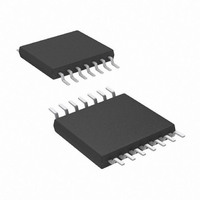AT89LP214-20XU Atmel, AT89LP214-20XU Datasheet - Page 29

AT89LP214-20XU
Manufacturer Part Number
AT89LP214-20XU
Description
MCU 8051 2K FLASH 20MHZ 14-TSSOP
Manufacturer
Atmel
Series
89LPr
Datasheet
1.AT89LP213-20PU.pdf
(98 pages)
Specifications of AT89LP214-20XU
Core Processor
8051
Core Size
8-Bit
Speed
20MHz
Connectivity
SPI, UART/USART
Peripherals
Brown-out Detect/Reset, POR, PWM, WDT
Number Of I /o
12
Program Memory Size
2KB (2K x 8)
Program Memory Type
FLASH
Ram Size
128 x 8
Voltage - Supply (vcc/vdd)
2.4 V ~ 5.5 V
Oscillator Type
Internal
Operating Temperature
-40°C ~ 85°C
Package / Case
14-TSSOP
Package
14TSSOP
Device Core
8051
Family Name
AT89
Maximum Speed
20 MHz
Operating Supply Voltage
2.5|3.3|5 V
Data Bus Width
8 Bit
Number Of Programmable I/os
12
Interface Type
SPI/UART
Number Of Timers
2
Core
8051
Processor Series
AT89x
Maximum Clock Frequency
20 MHz
Data Ram Size
128 B
Mounting Style
SMD/SMT
Height
1.05 mm
Length
5.1 mm
Maximum Operating Temperature
+ 85 C
Minimum Operating Temperature
- 40 C
Supply Voltage (max)
5.5 V
Supply Voltage (min)
2.4 V
Width
4.5 mm
Lead Free Status / RoHS Status
Lead free / RoHS Compliant
Eeprom Size
-
Data Converters
-
Lead Free Status / Rohs Status
Details
14.1
3538E–MICRO–11/10
Mode 0 – Variable Width Timer/Counter
However, the inputs may be exercised in software by toggling the P3.4 and P3.5 bits in the
Port 3 register.
Furthermore, the Timer or Counter functions for Timer 0 and Timer 1 have four operating modes:
variable width timer, 16-bit auto-reload timer, 8-bit auto-reload timer, and split timer. The control
bits C/T in the Special Function Register TMOD select the Timer or Counter function. The bit
pairs (M1, M0) in TMOD select the operating modes.
Both Timers in Mode 0 are 8-bit Counters with a variable prescaler. The prescaler may vary from
1 to 8 bits depending on the PSC bits in TCONB, giving the timer a range of 9 to 16 bits.
By default the timer is configured as a 13-bit timer compatible to Mode 0 in the standard 8051.
Figure 14-1
rolls over from all “1”s to all “0”s, it sets the Timer interrupt flag TF1. The counter input is enabled
to the Timer when TR1 = 1 and either GATE = 0 or INT1 = 1. Setting GATE = 1 allows the Timer
to be controlled by external input INT1, to facilitate pulse width measurements. TR1 is a control
bit in the Special Function Register TCON. GATE is in TMOD. The 13-bit register consists of all
8 bits of TH1 and the lower 5 bits of TL1. The upper 3 bits of TL1 are indeterminate and should
be ignored. Setting the run flag (TR1) does not clear the registers.
Note:
Figure 14-1. Timer/Counter 1 Mode 0: Variable Width Counter
Mode 0 operation is the same for Timer 0 as for Timer 1, except that TR0, TF0 and INT0 replace
the corresponding Timer 1 signals in
Timer 1 (TMOD.7) and one for Timer 0 (TMOD.3). The INT0 and INT1 pins are shared with the
XTAL oscillator. They may only be used for the GATE function when using the internal RC oscil-
lator as the system clock.
INT1 Pin
T1 Pin
RH1/RL1 are not required by Timer 1 during Mode 0 and may be used as temporary storage
registers.
GATE
OSC
shows the Mode 0 operation as it applies to Timer 1 in 13-bit mode. As the count
Mode 0:
TR1
÷TPS
Time-out Period
C/T = 0
C/T = 1
Control
Figure
=
14-1. There are two different GATE bits, one for
------------------------------------------------------ -
Oscillator Frequency
256
(8 Bits)
TL1
×
2
PSC0
(8 Bits)
+
TH1
1
PSC1
AT89LP213/214
×
(
TPS
TF1
+
1
)
Interrupt
29















